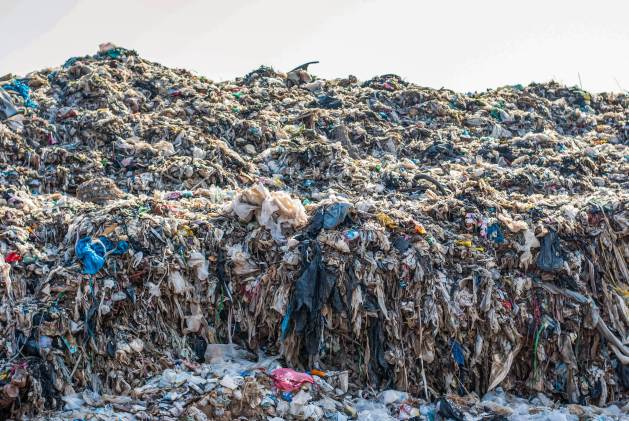Europe Sells to Africa and Asia 90% of Its Used Clothes, Textiles Waste — Global Issues
ROME, May 18 (IPS) – Once the money-making businesses have turned Asia and Africa into their low-cost factories, to produce and market at higher prices their clothes and footwear, obtaining more profits by selling to these two continents around 90% of all their used and textiles waste.
Not only: such a business alleviates the harsh environmental impacts of the lucrative clothing and fashion industry, and the cost of recycling and eliminating the leftovers of these products.
Just know that textiles are on average “the fourth-highest source of pressure on the environment and climate change from a European consumption perspective,” the European Environment Agency (EEA) on 26 April 2023 reported.
Consequently, “Europe faces major challenges managing used textiles, including textiles waste.”
Europe exports much more than textile waste
Lars Mortensen, EEA expert on circular economy, confirms that textile production and consumption in the European Union have significant impacts on the environment and climate.
“Textile consumption causes the third largest land use and water use in the value chain, and the fifth largest material resource use and greenhouse gas emissions. Also, textiles cause pressures and impacts from their chemicals on the environment and climate”.
The poisoning plastic
A 27 January 2023 EEA briefing focusses on another big problem: plastic.
“Plastic-based — or ‘synthetic’— textiles are woven into daily lives in Europe, in the clothes we wear, the towels and the bed sheets, in the carpets, curtains and cushions. And they are in safety belts, car tyres, workwear and sportswear.”
Synthetic textile fibres are produced from fossil fuel resources, such as oil and natural gas, the briefing goes on, adding that their production, consumption and related waste handling generate greenhouse gas emissions, use non-renewable resources and can release microplastics.
EU consumers discard about 5.8 million tonnes of textiles annually – around 11 kg per person – of which about two-thirds consist of synthetic fibres, according to the briefing.
“In Europe, about one-third of textile waste is collected separately, and a large part is exported.”
Africa and Asia are therefore the largest destinations of these toxic fibres.
Simply put: by exporting European used clothes and textiles waste, their impacts necessarily fall on the shoulders of Africans and Asians.
A highly uncertain fate
Indeed, “as reuse and recycling capacities in Europe are limited, a large share of used textiles collected in the EU is traded and exported to Africa and Asia, and their fate is highly uncertain,” says the European Environmental Agency.
In fact, throughout the past two decades, Africa has been the main continent receiving used textiles from the European Union (EU), importing more than 60% of EU exports.
But while in 2000 Asia received only 26% of EU exports, by 2019 it had significantly increased its share to 41% of EU imports. This is almost equal to Africa, which still imported 46% of EU exports.
Where do second-hand clothes end up?
In the African countries studied, the EEA report says that the import of used textiles seems to be mainly meant for local reuse. This is because there is a demand for cheap, used clothes from Europe, which seem to be preferred to new items.
“What is not fit for reuse mostly ends up in open landfills and informal waste streams.”
In Asia, however, most of the used textiles are imported to so-called economic zones where they are sorted and processed. In the countries studied for this briefing, import for local reuse is restricted.
Instead, used textiles seem to be recycled locally, mostly downcycled into industrial rags or filling, or re-exported either for recycling in other Asian countries or reuse in Africa.
“Textiles that cannot be recycled or re-exported are likely to end up in the general waste management system, most of which is landfilling.”
The big figures…
According to this European Union (EU)’s agency that ‘delivers knowledge and data to support Europe’s environment and climate goals’:
- The amount of used textiles exported from the EU has tripled over the last two decades from slightly over 550,000 tonnes in 2000 to almost 1.7 million tonnes in 2019.
- The fate of used textiles exported from the EU is highly uncertain. The perception of used clothing donations as generous gifts to people in need does not fully match reality,
- Used clothing is increasingly part of a specialised and traded global commodity value chain,
- In 2019, 46% of used textiles ended up in Africa: Imported, used textiles on this continent primarily go towards local reuse as there is a demand for cheap, used clothes from Europe. What is not fit for reuse mostly ends up in open landfills and informal waste streams,
- In 2019, 41% of used textiles ended up in Asia. Most used textiles on this continent are imported to dedicated economic zones where they are sorted and processed,
- The used textiles are mostly downcycled into industrial rags or filling, or re-exported for recycling in other Asian countries or for reuse in Africa. Textiles that cannot be recycled or re-exported are likely to end up in landfills.
… The big exporting hubs
“Some EU countries, such as Germany, Poland and the Netherlands, have exported more than others and seem to have acted as import-export hubs for used textiles from the EU.”
There is no clear reason explaining why five out of 27 EU Member States and the United Kingdom account for around 75% of all EU used textile exports, adds the EEA.
Therefore, it is likely that the largest exporters have been sending used textiles abroad, collected locally and from other EU countries, says the European agency.
Thus, another reason for the concentration of exports in a few EU countries could be that these large exporting countries are acting as export hubs.
“In other words, they are importing used textiles from other EU Member States for re-export beyond the EU. Ports/harbours for international shipment in some of these countries make them logical export hubs.”
Belgium, Italy and the Netherlands have large export harbours.
… and the big increase
EU used textile exports have grown significantly over the last two decades, the EEA reports, explaining that exports of textile waste outside the EU have been steadily increasing to reach 1.4 million tonnes in 2020.
Still, another problem appears: how to avoid that waste streams are falsely labelled as second-hand goods when exported from the EU and in this way escape the waste regime?
EU used textile exports are characterised by a lot of uncertainty, adds the EEA. First, there is uncertainty around the types of textiles exported as well as their quality.
In other words, it says, if used textiles exported from the EU are of too low quality to be reused, or are not reused for very long or do not replace new clothing purchases, they may not really replace new production or benefit the environment.
“Instead, the exports will only lead to more textiles ending up in landfills.”
© Inter Press Service (2023) — All Rights ReservedOriginal source: Inter Press Service
Check out our Latest News and Follow us at Facebook
Original Source







